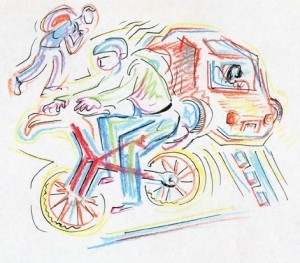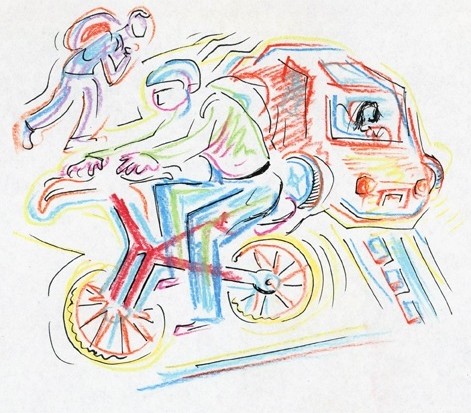
From biking to busing, and driving to longboarding, Stanford students — and college students across the country –have a variety of options when it comes to transportation.
For the most part, Stanford has everything a student needs right on campus, only a quick bike ride away from one’s dorm. But while biking is the most popular mode of transportation for students, there are a wide variety of transportation options available for students who opt for something other than two wheels.
On the Farm
For many, the choice of transportation depends on the destination.
“You can take the Marguerite a decent amount,” Keith Wyngarden ’15 said. “But it’ll only get you so far. The problem with the Marguerite is that you have to be proactive about schedule times and where you want to go has to be on [one of the routes].”
While the free bus system offers a total of 144 stops on or around campus, it is restricted to destinations in the Stanford area, as opposed to locations in nearby Mountain View and Redwood City. Even still, its reliability and price — or lack thereof< — makes the Marguerite a popular means of transportation for Stanford students without cars, or those simply unwilling to make the long walk or bike ride to reach downtown Palo Alto.
Some students choose another four-wheeled vehicle to get around — skateboards or longboards.
Owen Falk ’15 said he opts for boarding simply because it’s more fun than riding a bike.
Despite the board’s slower speed and lack of brakes, Falk said he finds it more enjoyable than most other modes of transportation.
Other popular options for students seeking more flexibility or to travel greater distances are rental car or ridesharing services, such as Zipcar and Wheelz.
Zipcar, a nationwide rental car company, allows students to sign up to rent one of 39 cars located in 16 locations on campus. Zipcar charges a $25 application fee, an annual fee of $60 and an hourly rate (roughly $8 an hour) during the actual period of use.
While Zipcar rents out cars specifically for student use, Wheelz, another rental car company, allows individuals in the Stanford area to rent out their personal cars to those in need of a temporary ride. Car owners are paid an hourly or daily amount based on how frequently their car is rented, with rates varying on the year, make and model of the car. As previously reported by the Daily, Wheelz recently received a $13.7 million dollar investment from Zipcar to expand the reach of its services.
Rental cars and ridesharing programs encourage carpooling in order to split the costs of driving a car, helping to reduce gas emissions and other harmful environmental effects.
Yet perhaps the most flexible mode of transportation for students — despite the associated costs — is the use of their own cars. While freshmen cannot apply for an on-campus parking permit, upperclassmen enjoy the freedom and utility the combination of bike and car ownership provides.
According to Shane Hegde ’13, having access to a car makes getting around the area — and off campus — much easier.
“I use my car about five times a week,” he said. “I get to go out with friends, I can go to the grocery store whenever I want — whenever is convenient.”
Rafael Witten ’12 uses a combination of bike and car transportation to get around, making sure to use a bike light at night, as he has had to attend bicycle diversion class through the Stanford Department of Public Safety.
Safe (and smart) travels
With all of the options available — from self-owned cars to Zipcars to the Marguerite — some students choose to factor in “green thinking,” making the most environmentally responsible decision.
Kenneth Qin ’15, green living coordinator in freshman dorm Soto in Wilbur Hall, argues it is necessary for people to consider environmental factors when evaluating their transportation choices, but he notes that the Stanford campus is already very environmentally conscious when it comes to these decisions.
“Stanford is such a green campus already,” he said. “I encourage people to live more environmentally-friendly lifestyles, but pretty much everyone uses bikes or public transit here.”
As Qin points out, biking or skateboarding are obviously the top choices for zero emissions travel. Stanford boasts 13,000 registered bicyclists on campus, according to Brodie Hamilton, director of Parking and Transportation Services (PTS).
However, with so much bike traffic, there are risks for bikers and non-bikers alike.
“Many fail to follow the rules of the road, like stopping at stop signs or yielding the right of way when appropriate, riding on the right side of the road or path, using a light when riding at night, riding too fast or while distracted,” Hamilton wrote in an email to The Daily.
He also added that helmet-wearing rates at Stanford are very low, citing a number of reasons including students feeling that they look “geeky,” that wearing a helmet is “uncool or contrary to the Stanford student culture” or that bikers do not want to pay for a helmet. He maintains that these are not justifying excuses.
“Students and their families make a considerable financial investment to attend Stanford,” he said. “Spending 10 to 15 dollars for a bike helmet is a cheap investment to protect the grey matter on which they are spending so much to educate.”
In order to combat this issue, PTS has founded numerous outreach programs to educate students on biking safety, even handing out free bike lights to a select number of dorms.
Comparisons across campuses
Like Stanford, colleges across the country boast a variety of transportation methods to cater to individual students’ needs and the demands of their specific campus locations.
UC-Davis, located in what is known as The Bicycle Capital of the United States, boasts that the name “Davis” and the word “bicycle” are synonymous, since the majority of all traffic near and on campus consists of bike traffic.
Like Stanford, Harvard University and Yale University host Zipcars on campus and encourage students to walk, bike or carpool when possible.
For instance, Yale boasts a car rental program, Relay Rides, which is similar to Stanford’s Wheelz. Through Relay Rides, the cars, typically owned by students, are rented out and returned at a time specified by the owner. As advertised on Yale’s website for Relay Rides, the program’s allows indivuals to choose a greater variety of cars than offered by Zipcar and many other rental car companies.
And what about Stanford’s rival across the Bay?
UC-Berkeley has a system much like the Marguerite, which shuttles travelers around campus and the nearby vicinity. Unlike the Marguerite, UC-Berkeley’s bus system, known as Bear Transit, is not free to the public. Much like at Stanford, however, a portion of UC-Berkeley’s student body own cars. According to the office of parking and transportation, only 53 percent of campus faculty and 92 percent of students commute by transportation other than solo driving.
As the various travel options at Stanford and its peer universities shows, transportation at college depends on students’ specific commuting needs, as well as their concern for safety and the environment. From biking to longboarding, students at Stanford and across the country have a variety of options to get where they need to go.
